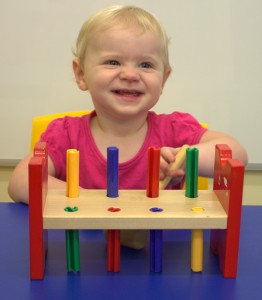 Last week we looked at how to help young children develop more single words. When children have developed a set of around 20 to 50 single words they begin to combine these together to express new more specific meanings such as “bye Dad”, “Mum car” and “more drink”. In typically developing children this begins at around 18 months and is well established by 2 years. Try these strategies and activities to help your child develop this stage which is a stepping stone to speaking in sentences.
Last week we looked at how to help young children develop more single words. When children have developed a set of around 20 to 50 single words they begin to combine these together to express new more specific meanings such as “bye Dad”, “Mum car” and “more drink”. In typically developing children this begins at around 18 months and is well established by 2 years. Try these strategies and activities to help your child develop this stage which is a stepping stone to speaking in sentences.
What is a two word combination? Young children use words a little differently to adults. Adults consider phrases such as “all gone” and “see you” two words, however young children tend to use them as if they are a single unit. They use them in the same way each time to express the same meaning. They don’t tend to say “all over” or “lucky you” in the way an adult can combine these words in different ways, so really they don’t count in the child’s mind as two separate words put together.
True two word combinations begin when the child takes two words they use alone and puts them together such as “hi Mum” or “look dog”. They might also take a word they know and add a new word to it such as “more banana” and “more swing”.
Two word combinations can include:
- Person + object "Alex shoe"
- Person + action "Alex jump"
- Action + person "kiss Nana"
- Action + object "kick ball"
- Description + object "big ball"
- Object + description "ball gone"
- Questions “Where’s Dad?
To help your child develop two word combinations: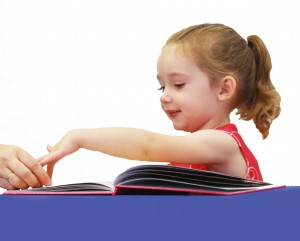
1. Build a solid base of single words. Children usually need around 50 single words before they begin this stage. Even after they begin to use two words they will need to continue to learn more single words to continue to develop their language skills. It is usually easier to learn a new word as a single word at this stage e.g. “zebra” then later combine it “baby zebra” “zebra eating” etc. Click here to download ideas and activities for developing single words.
2. Develop a variety of word types. Children begin by learning lots of names of people and things. To develop two word combinations they often need to combine these nouns with a different type of word such as an action word or a descriptive word. Action words are particularly important as they form the basis of sentences later on. Click here to download some printable activities for developing early vocabulary.
Help your child learn a range of different words including:
- action words: eat, sleep, jump, dance, run;
- describing words: big, funny, sad, hot, wet;
- position words; up, in, under,
- possessive words: mine, yours,
- greeting words: hi, bye,
- functional words: more, gone, no,
3. Expand the single words your child does say by adding another word. Try to repeat it a couple of times if you can.
Sometimes you might add another word you know they can say e.g. Child “bye” Adult “bye Dad, Dad’s going shopping, bye Dad”. Sometimes you might add a new word. Child “more” Adult “toast, more toast, you like the toast, more toast.”
Your child does not need to copy you, just hearing what you say will help and they will use that phrase when they are ready. If they do try to copy you though, respond positively. If what they say is not clear still be positive and say it again clearly for them. E.g. child “more toat” Adult “yes more toast”.

4. Practice games and activities where you can repeat the same word or two words over and over a number of times.
Activities could include:
- Bathtime: wash + body part “wash face, wash arms, wash tummy”
- Mealtime: eat + food name “eat peas, eat carrots, eat meat”
- Dressing: clothing name + on “shirt on, pants on, socks on, hat on”
- Ball play: action + ball “roll ball, push ball, kick ball, catch ball”
- Car play: car + action/position “ car go, car stop, car up, car in, car down”
- Block play "build up, more blocks, fall down"
- Outside play "Alex + run/jump/climb/slide" "Alex under/over/in/out/through"
- Hiding dolls or animals and finding them “hello teddy, goodbye puppy”.
- Matching games “Two apples, more dog”
Click here to download information on developing speech and language through play.
When your child does produce two words together all by themselves expand them to a short, simple sentence to keep them learning.
Moving on to sentences. Sentences need to contain an action word or verb, so developing your child's bank of verbs is very important to help them move onto the sentence stage.
There are different types of verbs or action words. Children begin by learning concrete actions that they do and see in their daily lives such as: run, jump, sleep, eat, and draw. Some verbs are less concrete such as: see, go, hear, like, say and look. Cognitive verbs talk about what happens in your head such as: think, decide, wonder, want and guess. Words such as “is, be and are” are verbs too.
Sentences begin either:
“action” + “object/person” such as “eat the apple” or “hug mummy”
or “object/person + action” such as “rabbit eats” or “Ben hugs”.
Children then begin to combine these into the form “person/object + action + object” such as “rabbit eats the apple” or “Ben hugs mummy”.
Finally children add descriptive words about how the action is done such as “the big rabbit eats the apple quickly” or “Ben hugs mummy everyday”.
Later they will begin to use conjunctions (joining words) to link sentences together "I went to the shops and we had an ice cream".
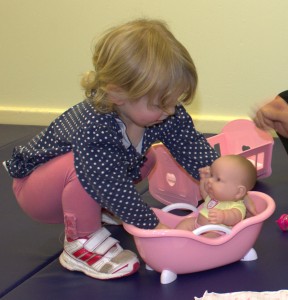
Here are some activities to practice at home to develop the use of action sentences:
5. In everyday activities eg: dressing, bathing, eating, shopping, housework talk to your child about what you and your child are doing, “look mum is cutting the carrots and peeling the potatoes”.
6. Look at pictures in books and talk about what people are doing. Books with simple bright pictures of children playing and doing familiar activities are good.
7. In favourite games and daily activities model action words in sentences.
- Craft: draw, colour, cut, glue, sprinkle, spread, stir, stick, peel.
- Playdough: roll, squeeze, poke, push, kneed, cut, stretch.
- Cooking: mix, cut, stir, spread, taste, smell, lick, bite, chew.
- Bath time: wash, splash, scrub, pour, drip.
8. Use dolls, plastic animals, teddies, or figurines to act out actions as you model the words, “look teddy is dancing, puppy is hiding”.
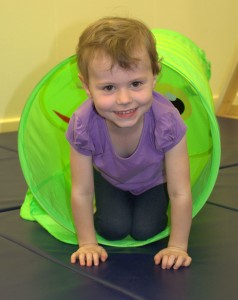
9. As your child begins to use sentences use modelling to help your child learn correct sentence structures.
To give your child the best possible model:
- Speak clearly
- Use short, easy to understand sentences
- Be a good listener and use eye contact while speaking
- Use facial and body gestures to support what you are saying and make your message clearer.
You can also use modelling to help your child correct their errors. In this case let your child hear how the sentence should be produced without pointing out errors. Children who constantly have their errors pointed out will often stop trying.
- Don’t expect your child to repeat after you when you model, let them ‘listen and learn’
- Try to repeat the corrected word multiple times to speed the rate of learning
- Your model might sound like this: eg: If your child said "the boy fast running" you would model: "Yes, the boy is running fast".
Place a little bit of emphasis on the corrections, but don't overdo this. By modelling the correct form back to him, he is getting the chance to learn the correct sentence, and will later begin to use the correct sentence.
10. As your child begins to use sentences you can also use "expansion" to gradually extend the length of their sentences. This means adding an extra word or phrase to their sentence. If your child says "the boy is running fast" you might say "the little boy is running fast" or "the boy is running fast up the hill".
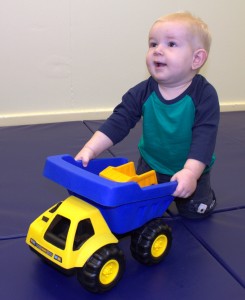
Children begin to combine words together at around 18 months of age and are confidently combining two words by two years of age. They are speaking in sentences by three years of age though grammar may still need some refining.
If you are concerned about your child's speech development you may wish to look at the checklist for your child's age on our website. Speech and language delays put children at risk of learning difficulties later on and early intervention is most effective. To find out more about how speech pathology can help your child's development click here.
To find out more about how the Talking Matters team can help your child click here. We provide speech pathology and occupational therapy services to children with a range of needs including autism spectrum disorders.
To find out more about Talking Matters visit us on our website, Facebook page, Twitter, or Pinterest. If you live in Adelaide and would like to discuss how Talking Matters can help your child call our friendly office staff on 08 (08) 8255 7137.
Jo Brenecki
Speech pathologist
Related Blog Posts
If you liked this post you may also like:
Best of 2016!
Christmas sparkle
Questions for preschool
Learning to manage emotions



